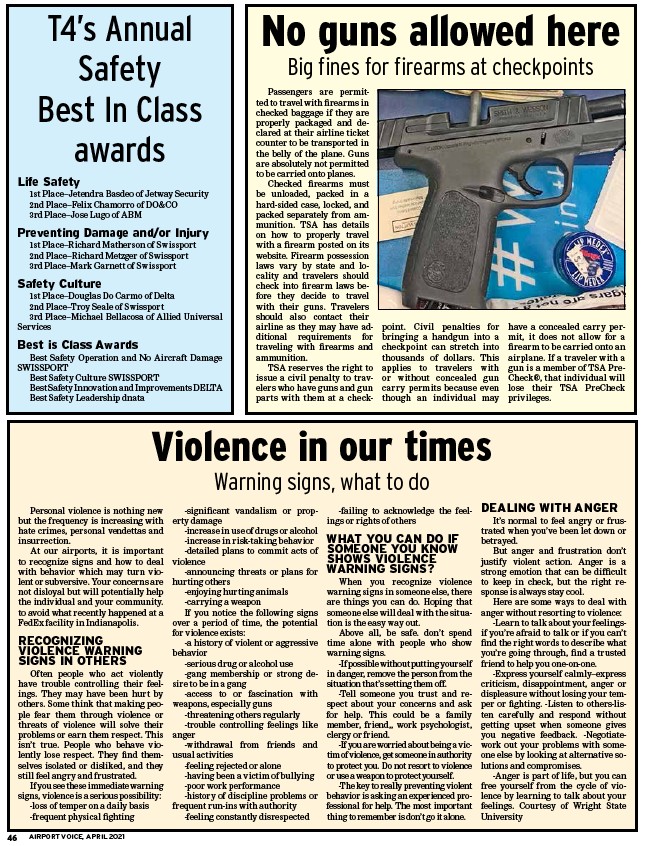
46 AIRPORT VOICE, APRIL 2021
Violence in our times
Warning signs, what to do
Personal violence is nothing new
but the frequency is increasing with
hate crimes, personal vendettas and
insurrection.
At our airports, it is important
to recognize signs and how to deal
with behavior which may turn violent
or subversive. Your concerns are
not disloyal but will potentially help
the individual and your community.
to avoid what recently happened at a
FedEx facility in Indianapolis.
RECOGNIZING
VIOLENCE WARNING
SIGNS IN OTHERS
Often people who act violently
have trouble controlling their feelings.
They may have been hurt by
others. Some think that making people
fear them through violence or
threats of violence will solve their
problems or earn them respect. This
isn’t true. People who behave violently
lose respect. They find themselves
isolated or disliked, and they
still feel angry and frustrated.
If you see these immediate warning
signs, violence is a serious possibility:
-loss of temper on a daily basis
-frequent physical fighting
-significant vandalism or property
damage
-increase in use of drugs or alcohol
-increase in risk-taking behavior
-detailed plans to commit acts of
violence
-announcing threats or plans for
hurting others
-enjoying hurting animals
-carrying a weapon
If you notice the following signs
over a period of time, the potential
for violence exists:
-a history of violent or aggressive
behavior
-serious drug or alcohol use
-gang membership or strong desire
to be in a gang
-access to or fascination with
weapons, especially guns
-threatening others regularly
-trouble controlling feelings like
anger
-withdrawal from friends and
usual activities
-feeling rejected or alone
-having been a victim of bullying
-poor work performance
-history of discipline problems or
frequent run-ins with authority
-feeling constantly disrespected
-failing to acknowledge the feelings
or rights of others
WHAT YOU CAN DO IF
SOMEONE YOU KNOW
SHOWS VIOLENCE
WARNING SIGNS?
When you recognize violence
warning signs in someone else, there
are things you can do. Hoping that
someone else will deal with the situation
is the easy way out.
Above all, be safe. don’t spend
time alone with people who show
warning signs.
-If possible without putting yourself
in danger, remove the person from the
situation that’s setting them off.
-Tell someone you trust and respect
about your concerns and ask
for help. This could be a family
member, friend,, work psychologist,
clergy or friend.
-If you are worried about being a victim
of violence, get someone in authority
to protect you. Do not resort to violence
or use a weapon to protect yourself.
-The key to really preventing violent
behavior is asking an experienced professional
for help. The most important
thing to remember is don’t go it alone.
DEALING WITH ANGER
It’s normal to feel angry or frustrated
when you’ve been let down or
betrayed.
But anger and frustration don’t
justify violent action. Anger is a
strong emotion that can be difficult
to keep in check, but the right response
is always stay cool.
Here are some ways to deal with
anger without resorting to violence:
-Learn to talk about your feelingsif
you’re afraid to talk or if you can’t
find the right words to describe what
you’re going through, find a trusted
friend to help you one-on-one.
-Express yourself calmly–express
criticism, disappointment, anger or
displeasure without losing your temper
or fighting. -Listen to others-listen
carefully and respond without
getting upset when someone gives
you negative feedback. -Negotiatework
out your problems with someone
else by looking at alternative solutions
and compromises.
-Anger is part of life, but you can
free yourself from the cycle of violence
by learning to talk about your
feelings. Courtesy of Wright State
University
T4’s Annual
Safety
Best In Class
awards
Life Safety
1st Place–Jetendra Basdeo of Jetway Security
2nd Place–Felix Chamorro of DO&CO
3rd Place–Jose Lugo of ABM
Preventing Damage and/or Injury
1st Place–Richard Matherson of Swissport
2nd Place–Richard Metzger of Swissport
3rd Place–Mark Garnett of Swissport
Safety Culture
1st Place–Douglas Do Carmo of Delta
2nd Place–Troy Seale of Swissport
3rd Place–Michael Bellacosa of Allied Universal
Services
Best is Class Awards
Best Safety Operation and No Aircraft Damage
SWISSPORT
Best Safety Culture SWISSPORT
Best Safety Innovation and Improvements DELTA
Best Safety Leadership dnata
No guns allowed here
Big fines for firearms at checkpoints
Passengers are permitted
to travel with firearms in
checked baggage if they are
properly packaged and declared
at their airline ticket
counter to be transported in
the belly of the plane. Guns
are absolutely not permitted
to be carried onto planes.
Checked firearms must
be unloaded, packed in a
hard-sided case, locked, and
packed separately from ammunition.
TSA has details
on how to properly travel
with a firearm posted on its
website. Firearm possession
laws vary by state and locality
and travelers should
check into firearm laws before
they decide to travel
with their guns. Travelers
should also contact their
airline as they may have additional
requirements for
traveling with firearms and
ammunition.
TSA reserves the right to
issue a civil penalty to travelers
who have guns and gun
parts with them at a checkpoint.
Civil penalties for
bringing a handgun into a
checkpoint can stretch into
thousands of dollars. This
applies to travelers with
or without concealed gun
carry permits because even
though an individual may
have a concealed carry permit,
it does not allow for a
firearm to be carried onto an
airplane. If a traveler with a
gun is a member of TSA Pre-
Check®, that individual will
lose their TSA PreCheck
privileges.